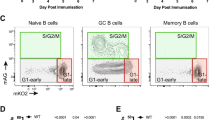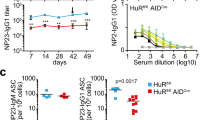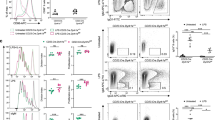Abstract
To identify genes and mechanisms involved in humoral immunity, we did a mouse genetic screen for mutations that do not affect the first wave of antibody to immunization but disrupt response maturation and persistence. The first two mutants identified had loss-of-function mutations in the gene encoding a previously obscure member of a family of Rho-Rac GTP-exchange factors, DOCK8. DOCK8-mutant B cells were unable to form marginal zone B cells or to persist in germinal centers and undergo affinity maturation. Dock8 mutations disrupted accumulation of the integrin ligand ICAM-1 in the B cell immunological synapse but did not alter other aspects of B cell antigen receptor signaling. Humoral immunodeficiency due to Dock8 mutation provides evidence that organization of the immunological synapse is critical for signaling the survival of B cell subsets required for long-lasting immunity.
This is a preview of subscription content, access via your institution
Access options
Subscribe to this journal
Receive 12 print issues and online access
$209.00 per year
only $17.42 per issue
Buy this article
- Purchase on Springer Link
- Instant access to full article PDF
Prices may be subject to local taxes which are calculated during checkout







Similar content being viewed by others
Change history
04 December 2009
In the version of this article initially published, the third author's name is missing the middle initial. The correct name is Andy L Johnson. The error has been corrected in the HTML and PDF versions of the article.
References
Conley, M.E. et al. Primary B cell immunodeficiencies: comparisons and contrasts. Annu. Rev. Immunol. 27, 199–227 (2009).
Park, M.A., Li, J.T., Hagan, J.B., Maddox, D.E. & Abraham, R.S. Common variable immunodeficiency: a new look at an old disease. Lancet 372, 489–502 (2008).
Schaffer, A.A., Salzer, U., Hammarstrom, L. & Grimbacher, B. Deconstructing common variable immunodeficiency by genetic analysis. Curr. Opin. Genet. Dev. 17, 201–212 (2007).
van Zelm, M.C. et al. An antibody-deficiency syndrome due to mutations in the CD19 gene. N. Engl. J. Med. 354, 1901–1912 (2006).
Tuveson, D.A., Carter, R.H., Soltoff, S.P. & Fearon, D.T. CD19 of B cells as a surrogate kinase insert region to bind phosphatidylinositol 3-kinase. Science 260, 986–989 (1993).
Castigli, E. et al. TACI is mutant in common variable immunodeficiency and IgA deficiency. Nat. Genet. 37, 829–834 (2005).
Salzer, U. et al. Mutations in TNFRSF13B encoding TACI are associated with common variable immunodeficiency in humans. Nat. Genet. 37, 820–828 (2005).
Grimbacher, B. et al. Homozygous loss of ICOS is associated with adult-onset common variable immunodeficiency. Nat. Immunol. 4, 261–268 (2003).
Wehr, C. et al. The EUROclass trial: defining subgroups in common variable immunodeficiency. Blood 111, 77–85 (2008).
MacLennan, I.C.M. et al. Extrafollicular antibody responses. Immunol. Rev. 194, 8–18 (2003).
Hande, S., Notidis, E. & Manser, T. Bcl-2 obstructs negative selection of autoreactive, hypermutated antibody V regions during memory B cell development. Immunity 8, 189–198 (1998).
Naparstek, Y. et al. A single germline VH gene segment of normal A/J mice encodes autoantibodies characteristic of systemic lupus erythematosus. J. Exp. Med. 164, 614–626 (1986).
Cote, J.-F. & Vuori, K. GEF what? Dock180 and related proteins help Rac to polarize cells in new ways. Trends Cell Biol. 17, 383–393 (2007).
Meller, N., Merlot, S. & Guda, C. CZH proteins: a new family of Rho-GEFs. J. Cell Sci. 118, 4937–4946 (2005).
Ruusala, A. & Aspenstrom, P. Isolation and characterisation of DOCK8, a member of the DOCK180-related regulators of cell morphology. FEBS Lett. 572, 159–166 (2004).
Yang, J., Zhang, Z., Roe, S.M., Marshall, C.J. & Barford, D. Activation of Rho GTPases by DOCK exchange factors is mediated by a nucleotide sensor. Science 325, 1398–1402 (2009).
Phan, T.G. et al. B cell receptor-independent stimuli trigger immunoglobulin (Ig) class switch recombination and production of IgG autoantibodies by anergic self-reactive B cells. J. Exp. Med. 197, 845–860 (2003).
Paus, D. et al. Antigen recognition strength regulates the choice between extrafollicular plasma cell and germinal center B cell differentiation. J. Exp. Med. 203, 1081–1091 (2006).
Phan, T.G. et al. High affinity germinal center B cells are actively selected into the plasma cell compartment. J. Exp. Med. 203, 2419–2424 (2006).
Kam-Morgan, L.N. et al. High-resolution mapping of the HyHEL-10 epitope of chicken lysozyme by site-directed mutagenesis. Proc. Natl. Acad. Sci. USA 90, 3958–3962 (1993).
Padlan, E.A. et al. Structure of an antibody-antigen complex: crystal structure of the HyHEL-10 Fab-lysozyme complex. Proc. Natl. Acad. Sci. USA 86, 5938–5942 (1989).
Hasbold, J., Corcoran, L.M., Tarlinton, D.M., Tangye, S.G. & Hodgkin, P.D. Evidence from the generation of immunoglobulin G-secreting cells that stochastic mechanisms regulate lymphocyte differentiation. Nat. Immunol. 5, 55–63 (2004).
Chan, T.D. et al. Antigen affinity controls rapid T-dependent antibody production by driving the expansion rather than the differentiation or extrafollicular migration of early plasmablasts. J. Immunol. 183, 3139–3149 (2009).
Li, Y., Li, H., Yang, F., Smith-Gill, S.J. & Mariuzza, R.A. X-ray snapshots of the maturation of an antibody response to a protein antigen. Nat. Struct. Biol. 10, 482–488 (2003).
Carrasco, Y.R., Fleire, S.J., Cameron, T., Dustin, M.L. & Batista, F.D. LFA-1/ICAM-1 interaction lowers the threshold of B cell activation by facilitating B cell adhesion and synapse formation. Immunity 20, 589–599 (2004).
Qi, H., Cannons, J.L., Klauschen, F., Schwartzberg, P.L. & Germain, R.N. SAP-controlled T-B cell interactions underlie germinal centre formation. Nature 455, 764–769 (2008).
Okada, T. et al. Chemokine requirements for B cell entry to lymph nodes and Peyer's patches. J. Exp. Med. 196, 65–75 (2002).
Arana, E. et al. Activation of the small GTPase Rac2 via the B cell receptor regulates B cell adhesion and immunological-synapse formation. Immunity 28, 88–99 (2008).
Croker, B.A. et al. The Rac2 guanosine triphosphatase regulates B lymphocyte antigen receptor responses and chemotaxis and is required for establishment of B-1a and marginal zone B lymphocytes. J. Immunol. 168, 3376–3386 (2002).
Doody, G.M. et al. Signal transduction through Vav-2 participates in humoral immune responses and B cell maturation. Nat. Immunol. 2, 542–547 (2001).
Tedford, K. et al. Compensation between Vav-1 and Vav-2 in B cell development and antigen receptor signaling. Nat. Immunol. 2, 548–555 (2001).
Walmsley, M.J. et al. Critical roles for Rac1 and Rac2 GTPases in B cell development and signaling. Science 302, 459–462 (2003).
Fukui, Y. et al. Haematopoietic cell-specific CDM family protein DOCK2 is essential for lymphocyte migration. Nature 412, 826–831 (2001).
Nombela-Arrieta, C. et al. Differential requirements for DOCK2 and phosphoinositide-3-kinase γ during T and B lymphocyte homing. Immunity 21, 429–441 (2004).
Wang, Y. et al. The physiologic role of CD19 cytoplasmic tyrosines. Immunity 17, 501–514 (2002).
Rickert, R.C., Rajewsky, K. & Roes, J. Impairment of T-cell-dependent B-cell responses and B-1 cell development in CD19-deficient mice. Nature 376, 352–355 (1995).
Engel, P. et al. Abnormal B lymphocyte development, activation, and differentiation in mice that lack or overexpress the CD19 signal transduction molecule. Immunity 3, 39–50 (1995).
Wang, Y. & Carter, R.H. CD19 regulates B cell maturation, proliferation, and positive selection in the FDC zone of murine splenic germinal centers. Immunity 22, 749–761 (2005).
Anzelon, A.N., Wu, H. & Rickert, R.C. Pten inactivation alters peripheral B lymphocyte fate and reconstitutes CD19 function. Nat. Immunol. 4, 287–294 (2003).
Depoil, D. et al. CD19 is essential for B cell activation by promoting B cell receptor-antigen microcluster formation in response to membrane-bound ligand. Nat. Immunol. 9, 63–72 (2008).
Fujimoto, M. et al. CD19 regulates Src family protein tyrosine kinase activation in B lymphocytes through processive amplification. Immunity 13, 47–57 (2000).
Zhang, Q. et al. Combined immunodeficiency associated with DOCK8 mutations. N. Engl. J. Med. published online doi:10.1056/NEJMoa0905506 (23 September 2009).
Martin, F. & Kearney, J.F. Positive selection from newly formed to marginal zone B cells depends on the rate of clonal production, CD19, and btk. Immunity 12, 39–49 (2000).
Okkenhaug, K. et al. Impaired B and T cell antigen receptor signaling in p110δ PI 3-kinase mutant mice. Science 297, 1031–1034 (2002).
Clayton, E. et al. A crucial role for the p110δ subunit of phosphatidylinositol 3-kinase in B cell development and activation. J. Exp. Med. 196, 753–763 (2002).
Lu, T.T. & Cyster, J.G. Integrin-mediated long-term B cell retention in the splenic marginal zone. Science 297, 409–412 (2002).
Guinamard, R., Okigaki, M., Schlessinger, J. & Ravetch, J.V. Absence of marginal zone B cells in Pyk-2-deficient mice defines their role in the humoral response. Nat. Immunol. 1, 31–36 (2000).
Koopman, G. et al. Adhesion through the LFA-1 (CD11a/CD18)-ICAM-1 (CD54) and the VLA-4 (CD49d)-VCAM-1 (CD106) pathways prevents apoptosis of germinal center B cells. J. Immunol. 152, 3760–3767 (1994).
Victoratos, P. et al. FDC-specific functions of p55TNFR and IKK2 in the development of FDC networks and of antibody responses. Immunity 24, 65–77 (2006).
Pulendran, B., Kannourakis, G., Nouri, S., Smith, K.G. & Nossal, G.J. Soluble antigen can cause enhanced apoptosis of germinal-centre B cells. Nature 375, 331–334 (1995).
Shokat, K.M. & Goodnow, C.C. Antigen-induced B-cell death and elimination during germinal-centre immune responses. Nature 375, 334–338 (1995).
Lucas, B. & Germain, R.N. Opening a window on thymic positive selection: developmental changes in the influence of cosignaling by integrins and CD28 on selection events induced by TCR engagement. J. Immunol. 165, 1889–1895 (2000).
Kishimoto, H. et al. Differing roles for B7 and intercellular adhesion molecule-1 in negative selection of thymocytes. J. Exp. Med. 184, 531–537 (1996).
Scholer, A., Hugues, S., Boissonnas, A., Fetler, L. & Amigorena, S. Intercellular adhesion molecule-1-dependent stable interactions between T cells and dendritic cells determine CD8+ T cell memory. Immunity 28, 258–270 (2008).
Horikawa, K. et al. Enhancement and suppression of signaling by the conserved tail of IgG memory-type B cell antigen receptors. J. Exp. Med. 204, 759–769 (2007).
Jun, J.E. et al. Identifying the MAGUK protein Carma-1 as a central regulator of humoral immune responses and atopy by genome-wide mouse mutagenesis. Immunity 18, 751–762 (2003).
Reif, K. et al. Balanced responsiveness to chemoattractants from adjacent zones determines B-cell position. Nature 416, 94–99 (2002).
Acknowledgements
We thank M. Townsend, D. Howard, H. Ferry and C. Gillespie for technical assistance; the staff of the Australian National University Bioscience Division and Oxford Biomedical Services Unit for animal husbandry; the Australian Phenomics Facility genotyping and mapping team for genetic analysis, R. Rigby, B. Balakishnan and L. Beaton (Australian National University) for advice and reagents; J. Cannons and P. Schwartzberg (National Institutes of Health) for B cell–T cell conjugation methods and SAP-deficient mice; C. Jenne, S. Watson and T. Pham (University of California, San Francisco) for collaboration; R. Schwartz (National Institutes of Health) for support with advice and reagents; and H. Su (National Institutes of Health) for sharing findings about human DOCK8 deficiency before publication. Supported by the Wellcome Trust (R.J.C. and C.C.G.), the Australian Research Council (C.C.G.), the National Health and Medical Research Council (C.C.G., R.B., S.G.T., C.G.V., F.M., K.L.R., L.E.T. and E.K.D.), the Medical Research Council (T.L. and R.J.C.), The Ramaciotti Foundation (A.E. and C.C.G.), Deutsche Forschungsgemeinschaft (A.E.), Cancer Research UK (F.D.B.), the Andrew McMichael Trust Fund (R.J.C.) and the National Institute for Health Research Biomedical Research Centre Programme (R.J.C.).
Author information
Authors and Affiliations
Contributions
T.L., K.L.R., A.L.J., T.B.-J. and B.W. mapped and identified the mutations; K.L.R. analyzed pri and complementation crosses with E.K., H.D., L.E.T. and A.E.; T.L. analyzed cpm with T.L.C., A.L.J., T.B.-J., D.A. and J.G.C.; B.T. and F.D.B. did synapse analysis; M.J.L. supervised early experiments on cpm by A.L.J.; F.M. and K.L.R. analyzed the effects of the BAFF transgene; E.K.D. and S.G.T. analyzed SAP-dependent B cell–T cell conjugation; K.L.R., T.D.C., T.C. and R.B. analyzed GC response in the SWHEL adoptive-transfer system; C.G.V. and E.K. designed and established the genetic screen and identified cpm and pri founders; C.C.G. and R.J.C. initiated and contributed to all aspects of study design and interpretation; and K.L.R., T.L., R.J.C. and C.C.G. wrote the paper in consultation with all coauthors.
Corresponding authors
Supplementary information
Supplementary Text and Figures
Supplementary Figures 1–13 and Supplementary Tables 1–2 (PDF 1179 kb)
Rights and permissions
About this article
Cite this article
Randall, K., Lambe, T., Johnson, A. et al. Dock8 mutations cripple B cell immunological synapses, germinal centers and long-lived antibody production. Nat Immunol 10, 1283–1291 (2009). https://doi.org/10.1038/ni.1820
Received:
Accepted:
Published:
Issue Date:
DOI: https://doi.org/10.1038/ni.1820
This article is cited by
-
Non-additive QTL mapping of lactation traits in 124,000 cattle reveals novel recessive loci
Genetics Selection Evolution (2022)
-
Dendritic cell migration in inflammation and immunity
Cellular & Molecular Immunology (2021)
-
Lineage-Specific Chimerism and Outcome After Hematopoietic Stem Cell Transplantation for DOCK8 Deficiency
Journal of Clinical Immunology (2021)
-
Interaction of septin 7 and DOCK8 in equine lymphocytes reveals novel insights into signaling pathways associated with autoimmunity
Scientific Reports (2018)
-
Human hyper-IgE syndrome: singular or plural?
Mammalian Genome (2018)



